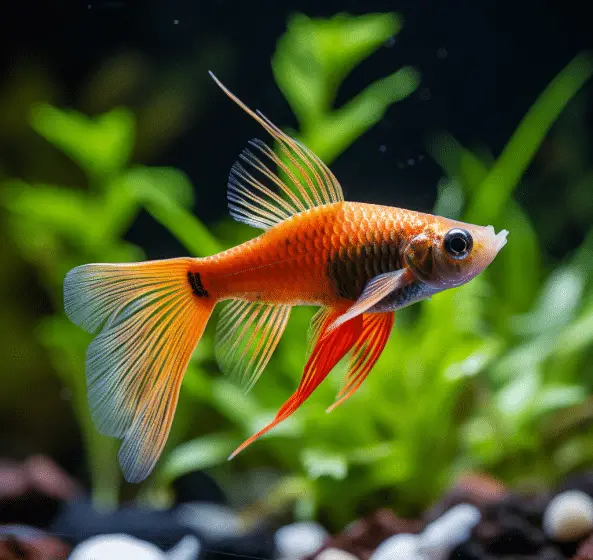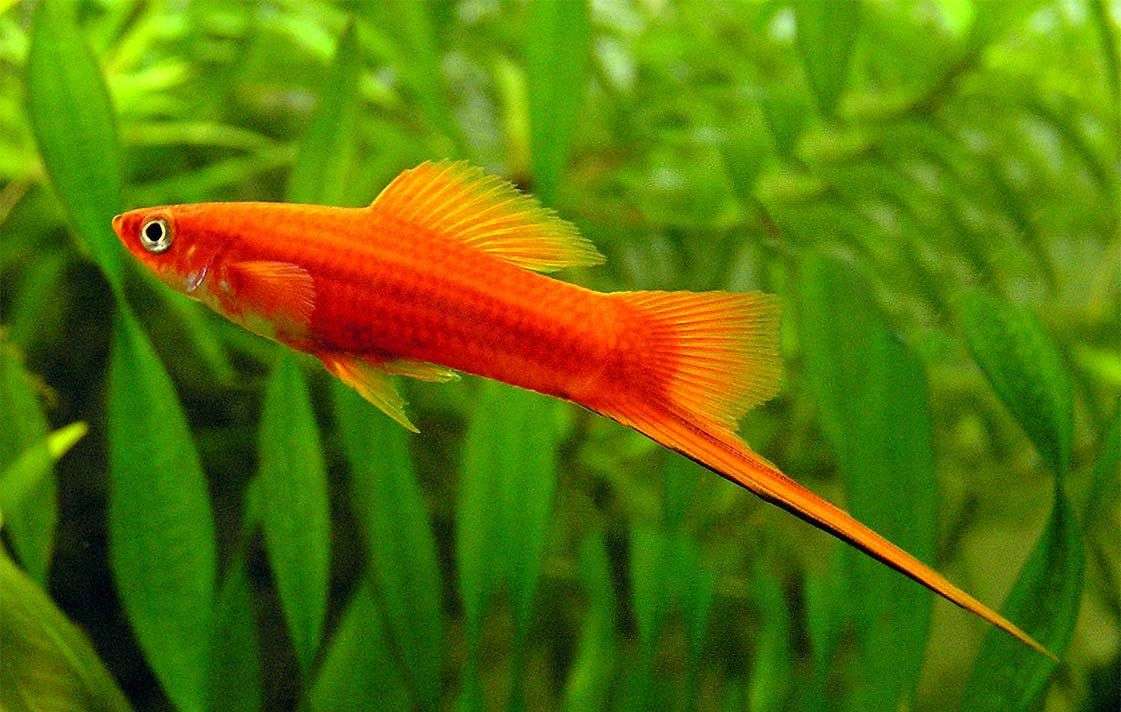How Big Do Swordtails Get

Introduction
How Big Do Swordtails Get: Swordtail fish, scientifically known as Xiphophorus hellerii, are enchanting aquatic creatures that have captured the hearts of aquarists and fish enthusiasts around the world. These freshwater fish, native to Central America, are renowned for their vibrant colors, distinctive sword-like tails, and lively behavior. As popular members of the aquarium community, understanding their size and growth potential is essential for providing them with the best care.
The size of swordtail fish plays a significant role in their suitability for aquarium settings. While they are not among the largest aquarium fish, they offer a wonderful balance between being large enough to appreciate their beauty and small enough to thrive in community tanks. This exploration delves into the typical size range of swordtail fish, which can vary slightly between individuals and sexes. Understanding their growth potential is crucial for creating a harmonious and well-maintained aquarium environment where these captivating fish can flourish.
Join us as we explore swordtail fish’s strange features, from their sword-like tails to their size differences. Whether you’re an expert aquarist or a beginner adding these energetic fish to your collection, understanding their size dynamics is essential to a healthy aquatic ecosystem.

At what age do swordtails breed?
You are welcome to mix different varieties together, but be ready for a swarm of baby swordtails if you mix males and females. Being live-bearing fish, swordtails can reproduce very quickly, reaching sexual maturity as early as three months of age.
Swordtail fish (Xiphophorus hellerii), like many livebearing fish species, are known for their relatively early sexual maturity. These fish can start breeding at a young age, often as early as 2 to 3 months old. The exact age at which they reach sexual maturity can be influenced by factors like water temperature, diet, and overall health.
One of the key factors influencing the early breeding age of swordtails is their livebearing nature. These fish give birth to live fry rather than laying eggs. As a result, they can produce offspring more quickly compared to species that lay eggs, as there is no need to develop and lay eggs.
This early breeding ability can cause swordtail populations to increase quickly in tanks and aquariums, therefore hobbyists must be aware of it. Preventing overpopulation and ensuring fish health in enclosed spaces requires proper breeding management.
How big do swordtail guppies get?
Average adult size: 2.5 inches (6.3 cm), females are larger. Average purchase size: 1 – 1.5 inches (2.5 – 3.8 cm) or larger.
Swordtail guppies, especially males, are prized for their sword-like tails. As with other guppies, swordtails are little, colorful fish.
Male swordtail guppies are slightly smaller than females and grow to 1.5 to 2.5 inches (3.8 to 6.4 cm). Male swordtail guppies’ sword-like tail extensions can add a half-inch to their length.
Swordtail guppies can live in community aquariums with other fish due to their modest size. Their brilliant colors, active temperament, and distinctive tails appeal to novice and seasoned aquarists. These little fish need proper care and an appropriate environment to thrive and show their full colors and habits.
What is the maximum length of a swordtail fish?
The male green swordtail grows to 14 centimetres (5.5 in) and the female to 16 (6.3 in). The male’s caudal fin’s enlarged lower lobe gives it the name’swordtail’
The habitat, nutrition, and genetics of swordtail fish (Xiphophorus hellerii) affect their maximum length. However, aquarium swordtail fish often grow to 2–4 inches (5–10 centimeters). Males are slightly smaller than females.
Male swordtail fish have a sword-like tail fin that adds length. Male fish appear larger due to their spectacular tails, which can be 1 to 2 inches long. The tail fin of females is more typical.
Note that swordtail fish’s maximum size depends on their tank or aquarium. Smaller tanks may impede fish growth and limit their size. Swordtail fish can grow to their full size in larger tanks with good conditions and a balanced diet. Proper aquarium upkeep is essential for swordtail fish health and growth.
It’s important to note that the maximum size of swordtail fish can also depend on the size of the tank or aquarium they are kept in. In smaller tanks, fish growth may be stunted, and they might not reach their full potential size. In larger tanks with suitable conditions and a well-balanced diet, swordtail fish have the opportunity to reach their maximum size. Proper care and maintenance of the aquarium environment are key to ensuring the health and growth of swordtail fish.
Do female swordtails have swords?
Abstract. Swordtail fish feature a conspicuous sexual dimorphism in the caudal fin structure: males have a colorful, elongated sword, whereas females do not.
Male swordtail fish (Xiphophorus hellerii) have sword-like tail fin extensions, whereas females do not. This is a key difference between male and female swordtails.
The male swordtail fish’s lower tail fin is pointed and extended like a sword, hence the name “swordtail.” Male swords vary in length, with some being longer and more apparent. The sword is used to pursue females and compete with other males for mating opportunities.
Instead of the sword-like extension, female swordtail fish have a rounded tail fin. Male tail fins are more ornamental and sleek by comparison. The absence of the sword is one of the main visible differences between male and female swordtail fish, utilized for gender identification in aquarium breeding and selection.
Are male swordfish bigger?
Females are larger than males, and Pacific swordfish reach a greater size than northwest Atlantic and Mediterranean swordfish. They reach maturity at 4–5 years of age and the maximum age is believed to be at least 9 years.
Male swordtail fish may appear larger than females due to their elongated sword-like tail fin. When they extend their swords during courting or aggression, male swordtails look larger than females due to their sword-like extension.
Female swordtail fish are similar in size to males, reaching 2 to 4 inches (5 to 10 centimeters). Males and females may differ in size due to genetics, food, and environment, not the sword.
Male swordtail fish use their swords for reproduction and socializing, not size. They use the sword to pursue possible mates and compete with other men for girls. Swords are visual indicators of male health and fitness, and females prefer longer swords during mate selection.
What is the typical size range for adult swordtail fish?
The typical size range for adult swordtail fish (Xiphophorus hellerii) is relatively small, making them suitable for community aquariums and popular choices among aquarists. These fish exhibit sexual dimorphism, with males and females having slightly different sizes. Adult swordtail fish usually range from 2 to 4 inches (5 to 10 centimeters) in length.
Male swordtail fish are generally slightly smaller than females, and their size can range from 2 to 3 inches. They are recognized by their elongated, sword-like tail fin, which is a distinguishing feature and can add to their overall length. The size and coloration of the sword can vary among individual males.
Female swordtails are 3–4 inches bigger. Female tail fins are rounder and lack the extended sword. Males and females are similar in size and have brilliant colors and patterns, making them popular among aquarium hobbyists. Adult swordtail fish need proper aquarium care to reach their full size and beauty.
Are there any factors that can affect the size of swordtail fish?
Yes, several factors can affect the size of swordtail fish, influencing whether they reach the upper or lower end of their typical size range. These factors include genetics, nutrition, environmental conditions, and the overall health of the fish.
- Genetics: Genetic factors play a significant role in determining the size of swordtail fish. Some individuals may have inherent growth patterns that lead to them being larger or smaller than their peers. Breeding programs may also select for specific size characteristics.
- Nutrition: Diet plays a crucial role in the growth of swordtail fish. Providing a well-balanced and nutritious diet with high-quality fish food can help ensure that these fish reach their full potential size. A varied diet that includes a mix of live, frozen, and flake or pellet foods can contribute to healthy growth.
- Environmental Conditions: The size of swordtail fish can be influenced by the conditions in their environment. Proper tank size, water quality, and appropriate tank mates can contribute to healthy growth. Overcrowding, inadequate tank size, or poor water quality can stunt growth and lead to smaller fish.
- Health: The overall health of swordtail fish also impacts their growth. Fish that are stressed, injured, or afflicted by diseases may not reach their full size potential. Maintaining a healthy environment and promptly addressing any health issues can help ensure optimal growth and size for these fish.
By carefully considering and managing these factors, aquarists can promote the healthy growth of swordtail fish and help them achieve their typical size range.
How does the size of male swordtails compare to that of females?
The size of male swordtail fish typically compares slightly smaller to that of females. Swordtail fish, like many species with sexual dimorphism, exhibit differences in size between males and females. These size differences are not substantial but are noticeable.
Male swordtail fish average 2–3 inches (5–7.5 cm) in length. Male swordtails’ extended, sword-like tail fins might distort their size. This extension can add 1–2 inches to the overall length, making male fish appear larger due to their magnificent tails.
However, female swordtail fish are larger, measuring 3–4 inches (7.5–10 cm). They lack males’ extended tail fins, giving them a conventional tail form. Though small, the size difference between male and female swordtail fish is one of the most important visual indicators of gender, especially for breeding and aquarium health.

Conclusion
Understanding the size dynamics of swordtail fish provides valuable insights into the world of these captivating aquatic creatures. Swordtails, known for their vibrant colors and distinctive sword-like tails, occupy a unique space in the hearts of aquarium enthusiasts. Their size is a pivotal factor when it comes to their suitability for different aquarium setups, and their growth potential can vary slightly between individuals and sexes.
This size range is large enough to enjoy their beauty yet tiny enough to live in community tanks. Males appear larger due to their longer tail fins, but they are actually the same size.
In aquariums, swordtail fish are versatile and appealing, and understanding their size helps aquarists give them the optimum environment. Whether you’re an experienced aquarium hobbyist or a beginner, understanding swordtail fish size dynamics is essential to caring for these vibrant and charming aquatic pets.



